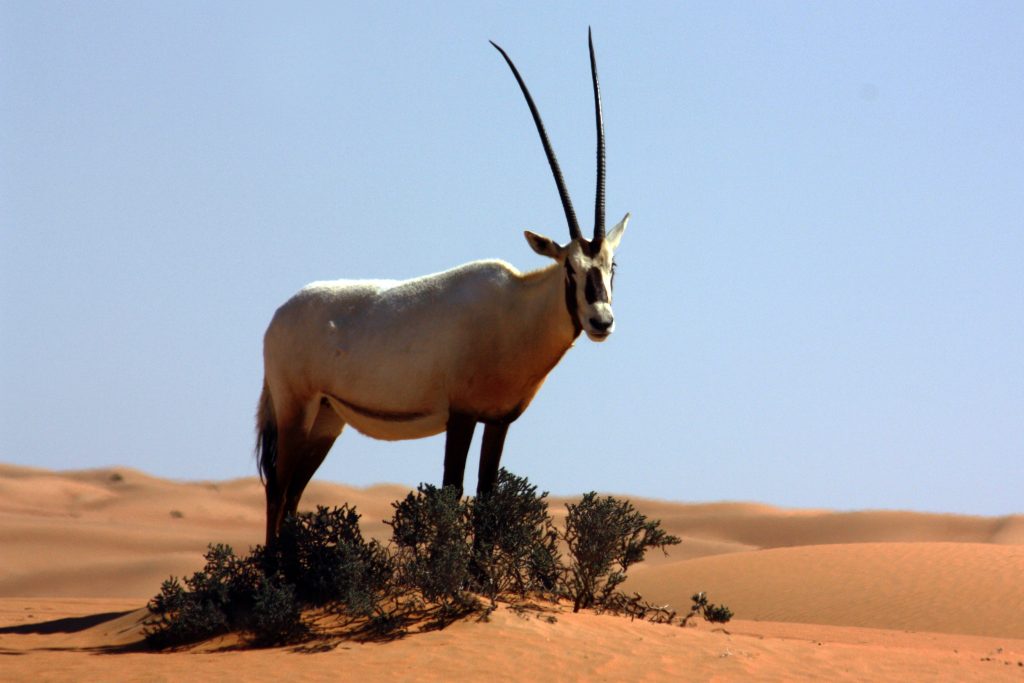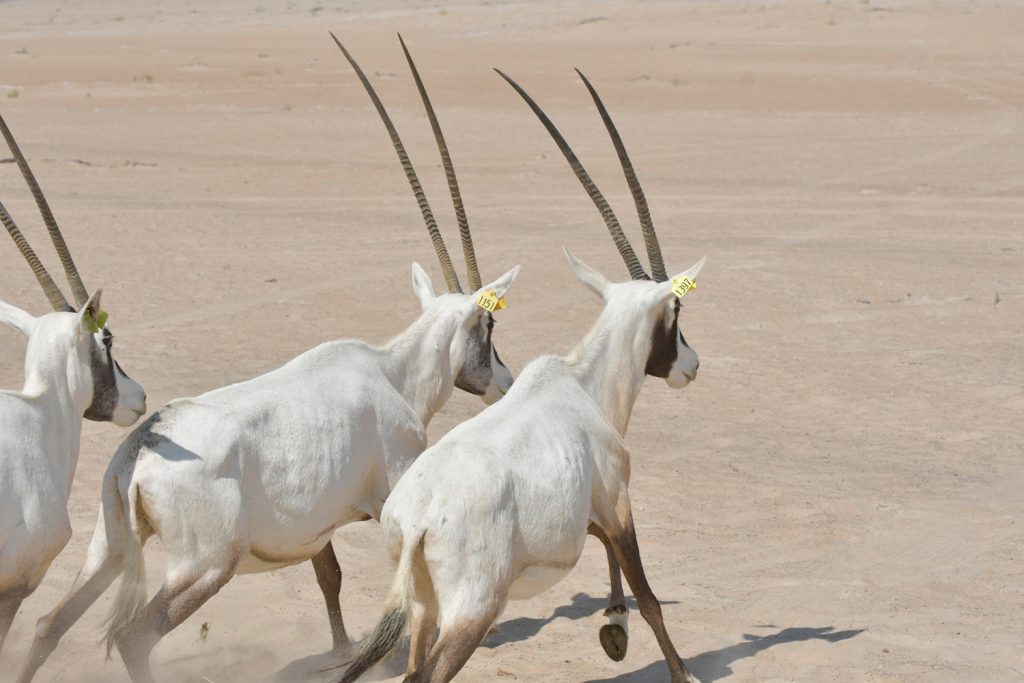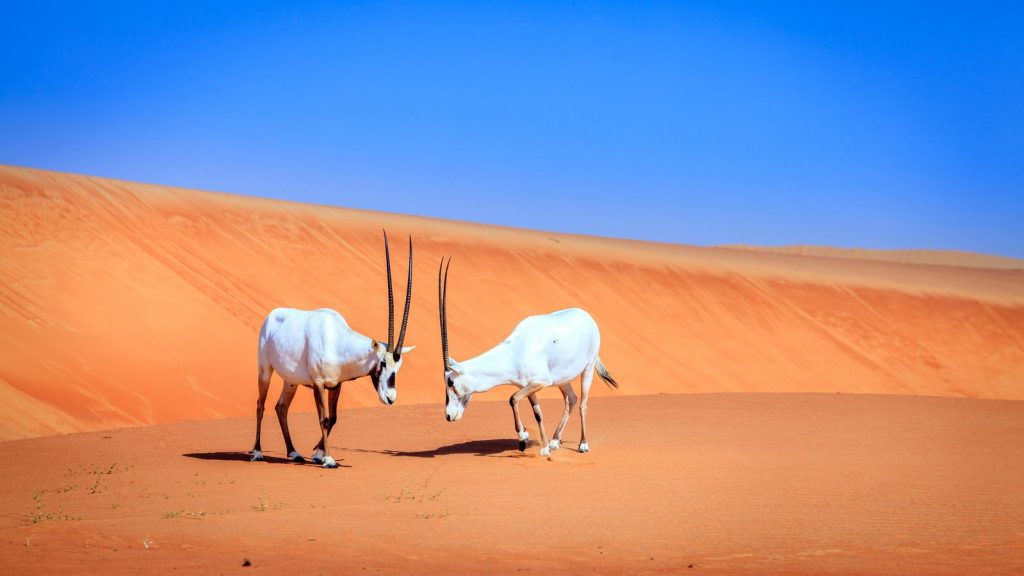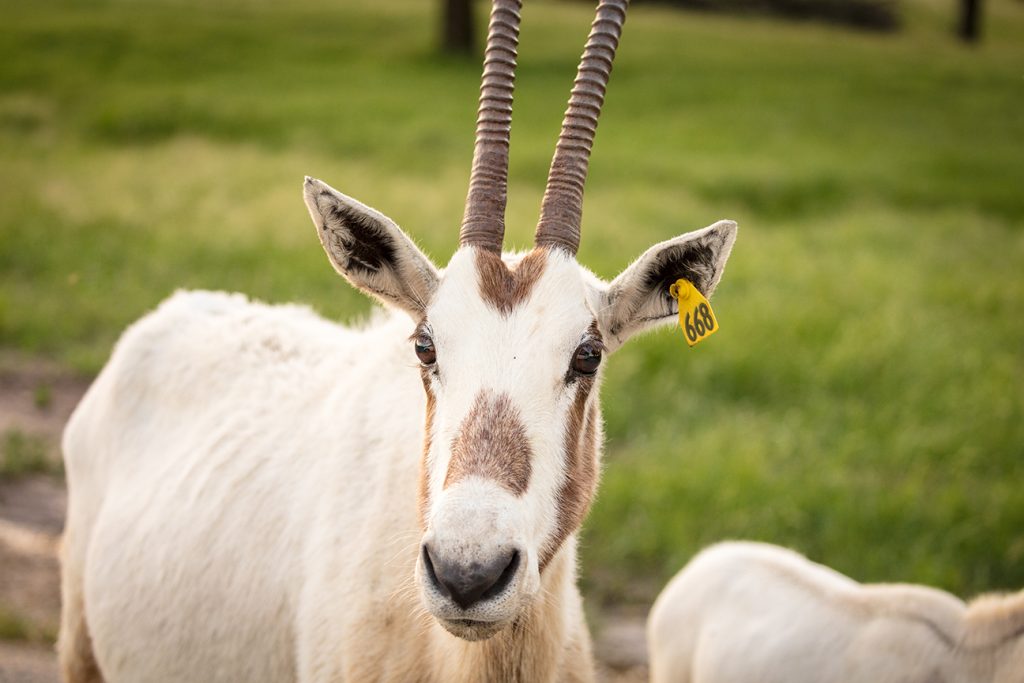Arabian Oryx is the United Arab Emirates’ official national animal. It is the largest mammal that lives in the deserts of Arab regions. This desert antelope is well suited to its rugged wilderness. Her glossy white coat represents the sun’s light, and her hooves stretch like a paddle, allowing the animal a wide field while walking on the sandy dirt. These animals are renowned for their endurance and grace and inspire Arab poets.
It is reintroduced at various locations in the United Arab Emirates, Saudi Arabia, the UAE, Israel, Syria, Jordan, Hawar Island of Bahrain, and prominent, semi-managed communities. The UAE National Animal, as Desert Oryx of the United Arab Emirates, is the most well-recognized among the citizens of the UAE. That is why it is appointed as the country’s official national animal. The national animal, the Arabian Oryx of the United Arab Emirates, has different males and females. The males are bucks, and the babies’ names are lamb and lambskin. However, the female representations are called a doe, dam.
However, many Arabian people and others are still confused about the national animal in UAE.
Arabian Oryx is the Symbol of the UAE
Oryx is most involved in the early morning and late evening. The United Arab Emirates (UAE) national animal is the Arabian Oryx. This list of UAE National Symbols concludes with the Al Ghaf tree as an inspiration for the logo. This change resulted from the Omani government’s decision to encourage petroleum extraction in most regions. The national fruit of the UAE is called the dates in Arabic. The poem described the colors of each UAE flag: white in good works, green in fertile fields, black in the darkness in battles, and red in spells.
Body Color and Shape Arabian Oryx

The UAE National Animal, Arabian Oryx, is almost light white, with the lower surfaces and legs dark, with black streaks where the spine, the brow, the nose, and the horn go into the muzzle. They are painted with a purple tail and tipped eyebrows in black. Its luminous cover serves to reflect the warmth of the sun. Both sexes’ long-ringed or gently angled horns measure 50 to 75cm long. Only in the dry Arab Peninsula, extinct in the wild, may the Oryx be a desert antelope. This antelope population is specialized in the insensitive wilderness. The hooves are sprinkled and slip-like, offering a prominent area on the sandy soil.
Arabian Oryx Distribution
The Arabian Peninsula is endemic to this species. In 1972, it was endangered in the wild but rescued by zoos and private reserves and reintroduced in the wild after 1980; accordingly, wilderness currently exists in Israel, Saudi Arabia, and Oman, and with the latest reintroduction schemes, this range may extend into other countries of the Arabian Peninsula. Arab Oryx lives in the arid deserts and plains of Arabia, where even in the shade during the summer, temperatures can exceed 50°C.
The legend of the unicorn is supposed to be based on oryxes that have lost a tail. Arabian Oryx are primarily grassy herbivores. The first site, in 2007, was withdrawn from the UNESCO World Heritage List at the Desert Oryx Sanctuaire in Oman. The bottom line was created in 1962 and consisted of three wilderness oryxes from Yemen, one from the zoo in London, and five from private collections from Saudi Arabia and Kuwait. Until 1972, no Arab oryx existed in the wild after establishing the UAE.
Horns Aplenty

Oryx have long, straight, slender horns with a distinctive anti-tube. These horns, both men and women, give Oryx the antelope nickname spear. The horns look a little different from the scimitar-horned Oryx. The name of this genus is taken from its long and angled horns, which are like Arabic blades called scimitars. The horns of the women are longer than those of the men in all six oryx species. In Africa, Oryx is sometimes called gemsbok, a UAE National Animal. But gemsbok in Germany, a form of goat-antelope, was the common name of chamois. With both a scientific name and a generic name, people worldwide know about the species.
Living Adaptations
Oryx live in desert, semi-desert, dry, and scrublands, which are open areas. Certain places can get very hot! But don’t be bothered. Desert Oryx has an odd circulating system in their brains. When you respire, you will cool down the blood that flows from your capillaries into your brain by raising the body’s temperature to 116 Fahrenheit. However, the fringe-oak Oryx can withstand periods of intense heat. Instead of sweating or evaporation, the sun leaves the ambient colder air in the body. Oryx digs low holes to relax and cool down when shade doesn’t exist, or it’s too humid.
The Arab Oryx is the most expert in the actual desert. The desert’s heat and sunshine represent its light hue. The animal will lift his fur to stay warm in his thick foundation on cold winter mornings. Even in the winter, Arab Oryx’s legs obscure to absorb some of the sun’s heat. These long oryx horns are helpful for predatory defense, such as leopards, lions, and hyenas. If attacked, gemsbok displays a unique behavior: it looks larger sideways. The gemsbok can defend or strike with its horns if the enemy loses.
The Diet Of Oryx

Oryx feeds only grass, trees, and bushes shoots and can traverse considerable lengths searching pasture. In 18 hours, one species is estimated to be 93 km long. They can live without drinking for long periods, seemingly fulfilling their water requirements from succulent and sometimes dew plants, but drink freely when available. They eat mostly early in the morning, at night, and perhaps evening.
Mating Habits
Polygynous breeders are Arabic Oryx. This means one male mum with several females in a single matching season. The birth schedule varies. However, if conditions are favorable, a woman will produce one calf a year in any month. Most births occur in imported herds in Jordan and Oman from October to May. The male Oryx with several women in a single breeding season was a polygynous breeder. There will be multiple birth occasions. However, a female can produce a single calf per year in a month when the conditions are favorable. Gestation takes about 240 days for this insect. Young women wean at 3.5-4.5 months, and women in captivity first give birth at 2.5-3.5 years.
The population of National Animal of UAE

The Bedouins on the Arabic peninsula hunt typical Arab Oryx for hides and fruit. However, after World War 2, when weapons and motorized transport became available, the complete decimation of this livestock occurred, and sport hunting demand was requested. The last recorded animal was fired in 1972, and the population was extinguished in inclement conditions. The reintroduction of cattle was successful in the 1990s, and welfare in Oman has once again been a severe threat.
Lifestyle
Gregarious species are Arab Oryx, and herds of 5 to 30 are formed, but more if conditions are good. In stormy conditions, communities consist of only one male and a few young females. Some men live a lonely life, including large fields. A power hierarchy is established in the herd by posing shows that protect the long, sharp horns from severe injuries. These animals appear capable of sensing snow from a long distance, leading almost nomadic lives in large areas looking for valuable new growth following the sporadic precipitation.
Camel VS Arabian Oryx

The Arab Oryx, not the camel, is the UAE National Animal. The camel is Saudi Arabia’s national mammal. However, according to the data from a public survey, many people in the country do not know their national animal. More than 1,200 polling respondents believe the national animal is camels. At the same time, just over 550 people correctly replied that the Arabian Oryx, also called the desert animal, is the UAE National Animal. The Sand Gazelle, the Tahr Arabic, and the Arab Leopard were other polling options. With 116 individuals who said it is a national species, the sand gazelle won the 3rd highest grade.
The same question was asked on social media networks, and most of the respondent’s responses ranged from camel, falcon, gazelle sand, and Arab camel. Residents like Abdul Hameed, who have lived in the UAE for 20 years, have indicated that people need more significant predominance in UAE landmarks to understand more about the Oryx.
Conclusion
Oryx is cautious, patient, and watchful. Your defense is to lower your head so your pointed horns go forward. These creatures have an odd device in their brains to cool their blood, which is valid for desert residents. In the distance, the Arab Oryx can detect rain. The head woman, Oryx, will carry her herd and search for the fresh grass the rainfall will have caused as the scent of rain is taken to the wind. To learn more about history, you might be interested in Historical Adventures.
